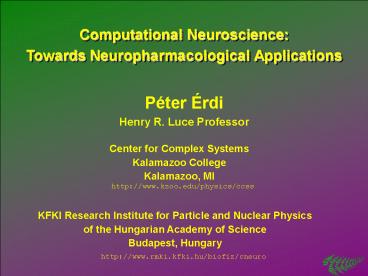Computational Neuroscience: - PowerPoint PPT Presentation
1 / 30
Title:
Computational Neuroscience:
Description:
Activity propagation in the feline cortex. Adaptation of the database by Scannel et. al. ... propagation in the feline cortex. Control. Dorsomedial prefrontal ... – PowerPoint PPT presentation
Number of Views:73
Avg rating:3.0/5.0
Title: Computational Neuroscience:
1
Computational Neuroscience Towards
Neuropharmacological Applications
Péter Érdi Henry R. Luce Professor
Center for Complex Systems Kalamazoo
College Kalamazoo, MI
http//www.kzoo.edu/physics/ccss
KFKI Research Institute for Particle and Nuclear
Physics of the Hungarian Academy of
Science Budapest, Hungary
http//www.rmki.kfki.hu/biofiz/cneuro
2
Contents
- Computational neuroscience microscopic and
macroscopic methods - Modeling the pharmacological modulation of the
septohippocampal system - Dynamical approach to neurology/psychiatry
3
Computational Neuroscience
Microscopic and Macroscopic Methods
4
Computational Neuroscience
Microscopic and Macroscopic Methods
The bottom-up modeling approach
SubneuralComponents
5
Computational Neuroscience
Microscopic and Macroscopic Methods
The top-down modeling approach
6
Computational Neuroscience
Microscopic and Macroscopic Methods
Describing morphology
Reverse engineering the brain, learning how its
components work...
Identifying ion channels
Adding synaptic connections
7
Single-cell models the compartmental technique
The Hodgkin-Huxley framework
8
Computational Neuroscience
Microscopic and Macroscopic Methods
Incorporating knowledge on the microscopic into
modeling the macroscopic
Measurement Theory Unit intracellular
recording Hodgkin-Huxley formalism EEG brain
imaging techniques Budapest Group
statistical neurodynamical approach to
activity propagation in neural populations
9
Computational Neuroscience
Microscopic and Macroscopic Methods
10
Computational Neuroscience
Microscopic and Macroscopic Methods
Activity propagation in the feline cortex
Dorsomedial prefrontal cortex inhibition induced
epilepsy
Control
high
low
population activity
From http//www.rmki.kfki.hu/biofiz/cneuro/tutoria
ls/duke/
11
Modeling the pharmacological modulation of the
septohippocampal system
12
Modeling the pharmacological modulation of the
septohippocampal system
Effects of reboxetine on theta activity
Control
After treatment with reboxetine
Hippocampal EEG
Fourier tr.
Cross corr.
13
Modeling the pharmacological modulation of the
septohippocampal system
Effects of desipramine on theta activity
Control
After treatment with reboxetine
Power
Frequency (Hz)
Hippocampal EEG
Fourier tr.
Cross corr.
14
Modeling the pharmacological modulation of the
septohippocampal system
Effects of fluvoxamine on theta activity
Control
Events (Hz)
Time (sec)
After treatment with reboxetine
Hippocampal EEG
Fourier tr.
Cross corr.
15
Towards a computational/physiological molecular
screening (and drug discovery)
Desired temporal pattern
Nontrivial
enhanced cognition
e.g. T
anxiogenics
Comp.
computational pharmaceutical modulation
interface tofurther testing
16
Modeling the pharmacological modulation of the
septohippocampal system
The septohippocampal system
Location of the hippocampus in rodents
Location of the hippocampus in human
17
Modeling the pharmacological modulation of the
septohippocampal system
The septohippocampal system
18
Modeling the pharmacological modulation of the
septohippocampal system
The septohippocampal system
Dentate Gyrus
C 50 - 100 D 15
granule cells
rat 600 - 1000 x 103
C, D 5 - 10 x 103
human 9000 x 103
CA3
pyramidal cells
Entorhinal Cortex
rat 160 x 103
C, D 103
human 2300 x 103
CA1
pyramidal cells
rat 250 x 103
human 4600 x 103
Subiculum
19
Modeling the pharmacological modulation of the
septohippocampal system
20
Modeling the pharmacological modulation of the
septohippocampal system
Simulation versus planning
Building mathematical models
Conduction computer experiments
Designing biological experiments
21
Modeling the pharmacological modulation of the
septohippocampal system
Simulation versus planning
Reversible and irreversible transition between
modes
KA
blockade
22
Modeling the pharmacological modulation of the
septohippocampal system
Computer Experiment
The experiment to be shown was done using the
GENESIS simulation environment.
A modified Traub94 type pyramidal neuron was
examined.
The model consists of 66 compartments for
dendrites, the soma and the axon. Current types
implemented are Ca2, KDR, KAHP, KA, KC and Na
currents. The model also accounts
for intracellular Ca2 concent- ration.
Current injection (10 nA)
Membrane potential vs. time curve measured in the
axon.
apical dendrites
Potential (V)
Recording site
soma
Time (sec)
axon
50 mV
-60 mV
basal dendrites
color code for membrane potential
23
Modeling the pharmacological modulation of the
septohippocampal system
Computer Experiment
Control hippocampal CA1 pyramidal neuron
24
Modeling the pharmacological modulation of the
septohippocampal system
Computer Experiment
Hippocampal CA1 pyramidal neuron after selective
blockade of KA channels
25
Dynamical approach to neurology/psychiatry
26
Dynamical approach to neurology/psychiatry
Schizophrenia
positive and negative symptoms
hallucination
uncomplicated actions and speech decreased
motivation
waving
steady
storage and recall of memory traces
changes in attractor structure pathological
attractors
27
Dynamical approach to neurology/psychiatry
The NMDA Receptor Delayed Maturation Hypothesis
28
Dynamical approach to neurology/psychiatry
The NMDA Receptor Delayed Maturation Hypothesis
29
Dynamical approach to neurology/psychiatry
Introduction to Attractors
30
Closing Words
One of the main intention of computational
neuroscience is to integrate anatomical,
physiological, neurochemical/pharmacological and
behavioural data by coherent concepts and models.
A basic structure for which such integration is
particularly important is the hippocampal
formation. Hippocampus has a crucial role in
cognitive processes, such as learning, memory
formation and spatial navigation. Many
neurological disorders, such as
epilepsy, Alzheimer diseases, depression,
anxiety, partially schizophrenia
are hippocampus-dependent diseases.
Computational models of normal and pathological
processes may help to develop more efficient
therapeutic strategies.































